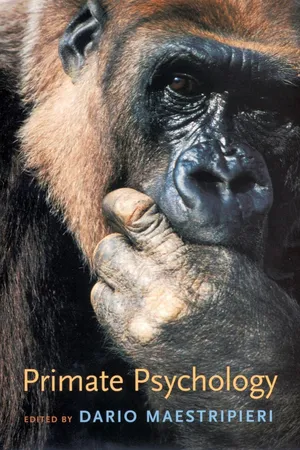Psychology
Animal Studies of Attachment
Animal studies of attachment involve research on the bonding and emotional connections between animals and their caregivers. These studies often use non-human subjects, such as primates or birds, to investigate the development and nature of attachment behaviors. Through observations and experiments, researchers aim to understand the factors that contribute to the formation and maintenance of attachment relationships in animals.
Written by Perlego with AI-assistance
Related key terms
1 of 5
4 Key excerpts on "Animal Studies of Attachment"
- eBook - PDF
- B.J. Casey(Author)
- 2008(Publication Date)
- American Psychiatric Association Publishing(Publisher)
The growth and acceptance of psychoanalytic object relations theory and the advent of parent–infant programs within psychoanalytic institutes have created new forms of treatment and fertile areas for research focused on early attachment. Within the fields of de- velopmental psychobiology and behavioral neuroscience, attach- ment has found a place as a unifying descriptive term for an area of research involving processes at work within close social rela- tionships. Among specific advances in our understanding of the component behavioral processes and neural mechanisms in- volved in the origin, maintenance, and termination of the attach- ment between the mammalian infant and its mother, siblings, and father, the idea of a neurobiology of attachment has become more than a figment of the imagination. I believe that the crucial step that has made a science of attach- ment possible has been the realization that its psychological con- structs could be analyzed at a level of component processes operating at a simpler level of organization. This new way of thinking allowed researchers to generate multiple hypotheses, each of which could be disproved or supported by experiments that gave unambiguous answers. Exploring this level of analysis has been exciting because it does not simply reduce the psycholog- ical questions to the most basic elements of biological organization (e.g., cells and molecules), trusting that eventually answers will come from “the bottom up.” Rather, this approach focuses on the 4 DEVELOPMENTAL PSYCHOBIOLOGY processes of behavioral organization and regulation that closely underlie psychological constructs, providing a link between psy- chology and the workings of the brain. New knowledge at this level of analysis seems to deepen our understanding of psycholog- ical processes, allowing us to modify our existing higher-level con- structs to make them more interesting and useful rather than claiming to eliminate the need for them. - eBook - ePub
Clinician's Guide to Treating Companion Animal Issues
Addressing Human-Animal Interaction
- Lori R. Kogan, Christopher Blazina(Authors)
- 2018(Publication Date)
- Academic Press(Publisher)
Chapter 11Pets and Relationships: How Animals Help Us Understand Ourselves and Our Connections With Others
Amy Johnson* ; Laura Bruneau†⁎ Oakland University, Rochester, MI, United States† Adams State University, Alamosa, CO, United StatesAbstract
This chapter explores how psychotherapists can incorporate companion animals into the psychotherapy process to better understand client relationships. Through careful assessment of the pet-owner dyad, psychotherapists may gain critical insight into clients’ interpersonal concerns and stressors. Additionally, psychotherapists can help clients gain insights into their intrapersonal beliefs, values, and conflicts, as well as interpersonal relationships and communication patterns. The subsequent sections of the chapter explore these therapeutic possibilities through the foundational lens of attachment theory and two specific clinical applications: family systems therapy and Gottman couple therapy. The latter two sections include practical applications to use with clients across therapeutic modalities.Keywords
Attachment theory; Family systems therapy; Gottman couple therapy; Pet-owner dyad; Human animal bondI like pondering our relationships with animals because they tell a lot about who we are. Marc BekoffOver the past century, theorists have conceptualized humans as dynamic, social beings who require a sense of love and belonging to thrive (Glasser, 1997 ; Maslow, 1954 ; Rogers, 1940 ). Positive, reciprocal interactions with family, friends, and societal groups can fulfill this need for love and affection. Feelings of love and belonging, which ultimately form attachments, strongly impact emotional patterns and how people make sense of their world (Baumeister & Leary, 1995 ). Further, Baumeister and Leary argued these fundamental human needs of love and belonging require the formation and maintenance of long-term, frequent, positive interpersonal experiences with important persons (1995 ). A lack of interpersonal attachments may cause emotional and psychological distress, and decrease overall levels of health and happiness (Mirowsky & Ross, 2003 ). Moreover, prolonged feelings of loneliness and worthlessness hinder growth (Snyder, Lopez, & Pedrotti, 2010 - eBook - PDF
- Dario Maestripieri, Dario Maestripieri, Dario MAESTRIPIERI(Authors)
- 2009(Publication Date)
- Harvard University Press(Publisher)
Unfortunately, such interactions have since become rare. Kondo-Ikemura and Waters (1995) suggested that the focus on individual differences in human attachment in the 1970s was an important source of the divergence between primate and human research. Whereas many attachment studies since the 1970s have concentrated on understanding individual differences in attach-ment, primate researchers have, in many cases, continued to refer to Bowlby’s original formulation of attachment theory, particularly his emphasis on nor-mative aspects of attachment and separation. Specifically, most empirical efforts by primatologists have gone into investigating the short- and long-term 114 = Primate Psychology responses of monkey infants to maternal separation. Such responses have been viewed as an important indicator of the strength of the attachment rela-tionship or of the role of the mother in social development. Attachment was initially conceptualized as a behavioral system and was therefore studied with behavioral measures in both human and nonhuman primates. Over the years, however, primate research has gradually shifted from behavioral to endocrine and neurobiological measures of attachment and separation, whereas the study of attachment in humans has become increasingly cognitive. Methodological changes in the study of primate attach-ment have been accompanied by attempts to reconceptualize attachment as a neurobiological system (Kraemer, 1992; Mason & Mendoza, 1998; Reite & Capitanio, 1985) and identify new or broader biological functions for this sys-tem (see below). Most empirical research on primate attachment, however, has been narrowly focused on the consequences of maternal separation and loss, and the reconceptualization of attachment has been strongly influenced by this work. The narrow focus of primate attachment research has had three negative consequences. - eBook - ePub
The Science inside the Child
The story of what happens when we're growing up
- Sara Meadows(Author)
- 2015(Publication Date)
- Routledge(Publisher)
We all need to learn to love and learn through loving. Only the stony-hearted would deny that loving and being loved by other people is important for the happiness of the child (and the parent). The theory about what love does for you has developed in ways that involve contributions from many scientific disciplines – evolutionary theory, brain development, endocrinology, ethology, anthropology – and it is one of the star areas of developmental psychology. There are enormous implications for child development and parenting.At the core of the psychology of this is John Bowlby's work on attachment, which was influenced by a wide range of factors – his own personal history, his observation of deeply troubled children in a school where he taught, his training in and use of psychoanalysis, his scientific interest in evolution and animal behaviour. The place that love plays in the child's life has both biological and social bases. Babies and young children have a strong need for protection, nurturance, care, and comforting. Being able to get other people to look after your interests preserved the safety and well-being of generations of ancestors, so it's not a surprise that babies are born with an evolved capacity to relate to significant others; to seek to be close to them; to rely on them for the fulfilment of their needs for nurture, protection, and relief from distress; to feel happier and more confident when they are within reach. Behaviours such as smiling, watching, seeking to hold the gaze of the other, crying, following, clinging to, snuggling up to, and using your attachment figure as a base and reference point are all biologically programmed to develop and maintain attachment relationships, and staying near to your attachment figure should help to keep the very young out of danger.We see these behaviours in many other species. Attachment is something that is universal in normal children and in a lot of other young animals. Chicks, lambs, calves, foals, and many other animals seek to be near their mothers; they have special distress calls which attract her attention and she has special calls to summon them back to her. Many birds who are able to walk soon after they hatch quickly develop a preference for following their mother, though they can be tricked into ‘imprinting’ on someone else if they see the someone else moving in the right way at the critical period of time. Konrad Lorenz easily taught the geese he bred to follow him like they would naturally follow their mother. Birds who have been induced to imprint on the wrong sort of object (a bird of a different species, for example – or a human ethologist) may look for creatures like it to mate with when they are adults. In King Solomon's Ring, Lorenz tells a number of anecdotes about imprinted animals ‘falling in love’ with an inappropriate partner from a different species.142
Index pages curate the most relevant extracts from our library of academic textbooks. They’ve been created using an in-house natural language model (NLM), each adding context and meaning to key research topics.



